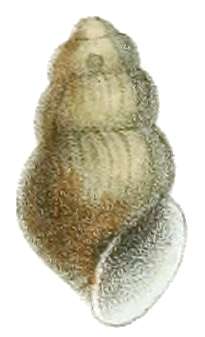Cylindrical lioplax
The cylindrical lioplax, scientific name Lioplax cyclostomaformis, is a species of freshwater snail with gills and an operculum, an aquatic gastropod mollusk in the family Viviparidae.
| Cylindrical lioplax | |
|---|---|
 | |
| An 1870 drawing of the shell of Lioplax cyclostomaformis | |
| Scientific classification | |
| Kingdom: | |
| Phylum: | |
| Class: | |
| (unranked): | |
| Superfamily: | |
| Family: | |
| Subfamily: | Lioplacinae |
| Genus: | |
| Species: | L. cyclostomaformis |
| Binomial name | |
| Lioplax cyclostomaformis I. Lea, 1841 | |
This species is endemic to the United States.
Description
The shell is elongate, reaching about 28 millimeters (mm) (1.1 inches (in)) in length. Shell color is light to dark olivaceous-green externally, and bluish inside of the aperture (shell opening).
The cylindrical lioplax is distinguished from other viviparid (eggs hatch internally and the young are born as juveniles) snails in the Mobile River Basin by the number of whorls, and differences in size, sculpture, microsculpture, and spire angle.
Distribution
This species is endemic to the United States.
No other species of lioplax snails are known to occur in the Mobile River Basin (see Clench and Turner, 1955[2] for a more detailed description).
Collection records for the cylindrical lioplax exist from the Alabama River (Dallas County, Alabama), Black Warrior River (Jefferson County, Alabama) and tributaries (Prairie Creek, Marengo County, Alabama; Valley Creek, Jefferson County, Alabama); Coosa River (Shelby, Elmore counties, Alabama) and tributaries (Oothcalooga Creek, Bartow County, Georgia; CoahuIla Creek, Whitfield County, Georgia; Annuchee Creek, Floyd County, Georgia; Little Wills Creek, Etowah County, Alabama; Choccolocco Creek, Talladega County, Alabama; Yellowleaf Creek, Shelby County, Alabama); and the Cahaba River (Bibb, Shelby counties, Alabama) and its tributary, Little Cahaba River (Jefferson County, Alabama).[2]
A single collection of this species has also been reported from the Tensas River, Madison Parish, Louisiana;[3] however, there are no previous or subsequent records outside of the Alabama-Coosa system, and searches of the Tensas River in Louisiana by Service biologists (1995) and others[4] (Vidrine, 1996) have found no evidence of the species or its typical habitat.
The cylindrical lioplax is currently known only from approximately 24 kilometers (km) (15 miles (mi)) of the Cahaba River above the Fall Line in Shelby and Bibb counties, Alabama.[5] Survey efforts by Davis[6] failed to locate this snail in the Coosa or Alabama rivers, and more recent survey efforts have also failed to relocate the species at historic localities in the Alabama, Black Warrior, Little Cahaba, and Coosa rivers and their tributaries.[5][7][8][9]
It is listed as endangered in the United States Fish and Wildlife Service list of endangered species since October 28, 1998 (according to report 63FR57619).[10]
Ecology
Little is known of the biology or life history of the cylindrical lioplax.
Habitat
Habitat for the cylindrical lioplax is unusual for the genus, as well as for other genera of viviparid snails. It lives in isolated mud deposits found under large rocks in the rapid flowing sections of stream and river shoals. Other lioplax species are usually found along the margins of rivers in exposed muddy substrates.
Feeding habits
It is believed to brood its young and filter-feed, as do other members of the Viviparidae.
Life cycle
Life spans have been reported from 3 to 11 years in various species of Viviparidae.[11]
References
This article incorporates public domain text (a public domain work of the United States Government) from the reference.[12]
- Bogan, A.E. 1996. Lioplax cyclostomaformis. 2006 IUCN Red List of Threatened Species. Archived June 27, 2014, at the Wayback Machine Downloaded on 7 August 2007.
- Clench, W.J. and R.D. Turner. 1955. The North American genus Lioplax in the Family Viviparidae. Occasional Papers on Mollusks. 2(19):1-20.
- Clench, W.J. 1962. New records of the genus Lioplax. Occasional Papers on Mollusks. 2(27):288.
- Vidrine, M.F. 1996. River survey of freshwater mollusks of Tensas River system in northeastern Louisiana. Report to Natural Heritage Program, Louisiana Department of Wildlife and Fisheries, Baton Rouge, LA. 135 pp.
- Bogan, A.E. and J.M. Pierson. 1993b. Survey of the aquatic gastropods of the Cahaba River Basin, Alabama: 1992. Alabama Natural Heritage Program. Contract Number 1922.
- Davis, G.M. 1974. Report on the rare and endangered status of a selected number of freshwater Gastropoda from southeastern U.S.A. Report to the U.S. Department of Interior, Fish and Wildlife Service, Washington, D.C. 51 pp. 25 maps.
- Bogan, A.E. and J.M. Pierson. 1993a. Survey of the aquatic gastropods of the Coosa River Basin, Alabama: 1992. Alabama Natural Heritage Program. Contract Number 1923.
- U.S. Fish and Wildlife Service. 1993. Endangered and threatened wildlife and plants; endangered status for three aquatic snails, and threatened status for three aquatic snails in the Mobile River basin of Alabama. Federal Register 63:57610-57620.
- M. Pierson, in litt., 1993, 1994
- U.S. Fish & Wildlife Service. Cylindrical lioplax (snail) (Lioplax cyclostomaformis). Accessed 27 November 2008.
- Heller, J. 1990. Longevity in molluscs. Malacologia 31(2):259-295.
- U.S. Fish and Wildlife Service. 2005. Recovery Plan for 6 Mobile River Basin Aquatic Snails. U.S. Fish and Wildlife Service, Jackson, Mississippi. 46 pp., page 3-4.
